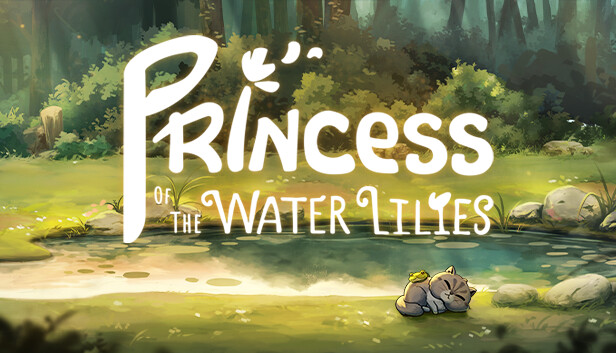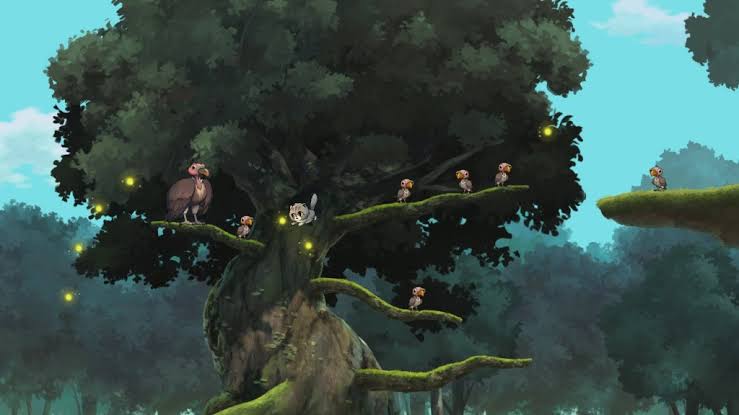
Princess of the Water Lilies is a deceptively gentle 2D puzzle‑platformer that lures you in with a storybook veneer; hand‑drawn ponds, drifting lily pads, and a wide‑eyed cat raised by frogs; then reveals itself as a finely tuned precision platformer. Your magical collar, activated by a single purr, is both tool and language: it makes vines unfurl, bridges bloom, and hidden paths materialize, turning the environment into a living puzzle to be read and manipulated.
Early moments feel cozy and exploratory, but the game quickly layers in timing‑critical platforming and multi‑stage challenges that demand pattern recognition, split‑second execution, and thoughtful sequencing. Chapter‑ending boss encounters sharpen that focus into tense, memorable tests of mastery, while the game’s visual warmth and orchestral score keep every victory emotionally resonant.
The result is a compact, artful experience that marries nostalgic animation‑era charm with modern, exacting design; inviting players to slow down, observe, and then execute with precision.
Gameplay and Mechanics
The collar is the game’s beating heart: a single purr releases a bloom of magic that makes vines unfurl, bridges sprout, and hidden pathways materialize, turning the world itself into a living puzzle. Early rooms teach you to coax individual elements; grow a step, raise a platform, freeze a flow; while later stages stitch those interactions into multi‑stage sequences that demand foresight, timing, and nimble execution.
As the collar evolves it grants new movement toys; vine‑swinging, refined water traversal, and other traversal upgrades; that not only open fresh puzzle solutions but also deepen the platforming vocabulary, letting you chain tricks and improvise on the fly. The loop is elegantly paced: curiosity is rewarded, experimentation yields satisfying “aha” moments, and mechanical depth accumulates naturally so each new ability reframes what the level design can ask of you.

Difficulty and Boss Design
Don’t let the cuddly protagonist fool you: the game pivots fast from cozy exploration to razor‑edged precision. Boss encounters arrive early and recur frequently, recasting the experience into a souls‑like test of pattern recognition and execution; one‑hit deaths, narrow timing windows, and arenas that force you to master both the boss’s rhythms and the level’s hazards. When everything clicks, these fights are electrifying: tense, fair, and deeply rewarding.
But they also produce abrupt difficulty spikes that can jar players who expected a gentle stroll; the difference between a thrilling comeback and a frustrating reset often comes down to two practical things: checkpoint placement and visual clarity during chaotic moments. Tighter checkpointing, clearer telegraphs for attacks, and a few readability tweaks would preserve the challenge while making those high‑stakes encounters feel more deliberate than punitive.

Art, Sound, and Storytelling
Visually, the game reads like a love letter to classic hand‑drawn animation: layered, painterly backgrounds, fluid character work, and tiny motion flourishes; fluttering petals, rippling water, a whisker twitch; that give each biome its own personality and invite slow, appreciative exploration. The orchestral score is a revelation, moving effortlessly from lullaby‑soft motifs to tense, cinematic swells that punctuate danger and amplify emotional beats, with recurring themes that make key moments feel earned.
Storytelling leans on visual clarity and economy: icons, illustrated emojis, and expressive animation carry the narrative without a single line of dialogue, making the plot instantly accessible across languages while preserving a surprisingly deep emotional throughline; especially in scenes where mechanical foes shed their shells and return to animal form, a transformation that lands because the art and music have already done the heavy lifting.

Strengths and Areas to Improve
The game’s strengths are unmistakable: beautiful, hand‑drawn environments, cleverly layered level design, and a rich orchestral soundtrack that lifts every scene from quaint to cinematic.
Puzzles are smartly constructed and the platforming feels precise, so repeated attempts reward learning rather than frustration. That said, the difficulty curve is sharper than the “casual” tag implies and can catch players off guard.
A few targeted improvements would broaden its appeal without diluting its character: clearer difficulty labeling, more consistent checkpoint placement, improved visual readability during hectic boss encounters, and an optional content warning for scenes involving animal distress.
Adding small accessibility and comfort options; adjustable flash intensity, fully remappable controls, checkpoint tuning or assist presets, and clearer telegraphs for enemy attacks; would let more players tailor the experience to their skill and sensitivity while preserving the game’s satisfying challenge.

Final Verdict
Princess of the Water Lilies is a quietly brilliant platformer that wears its charm like a soft cloak before revealing a core of razor‑sharp precision; what begins as cozy exploration quickly deepens into exacting, pattern‑driven challenges.
When mechanics and music lock together; a perfectly timed purr, a bridge unfurling at the right moment, a boss rhythm finally cracked; the game delivers genuinely cinematic, stick‑with‑you moments. Its handcrafted biomes, clever environmental puzzles, and expressive animation reward curiosity and careful observation, while the boss encounters push players to refine timing and read telegraphs with surgical focus.
This isn’t a casual stroll: patience, practice, and a willingness to learn from failure are part of the bargain, but they pay off in emotional payoffs and satisfying mastery that dialogue could never convey. If you prize artistry, thoughtful level design, and tense, memorable boss duels, this is a small masterpiece worth seeking out.
Watch and Wishlist
Add Princess of the Water Lilies to your wishlist on Steam, the Epic Store, or your console storefront to get notified about launch discounts, demos, and post‑release updates; follow Whyknot Studio and Red Dunes Games on social channels for developer diaries, patch notes, and community events that often reveal balance tweaks, accessibility options, and new modes.
Keep an eye out for weekend free plays or demo windows so you can test the difficulty and boss pacing with a controller before buying, and watch streams and community guides for tips on tricky boss patterns and puzzle solutions.
If you care about audio, watch for a soundtrack release or composer posts, this game’s orchestral score is a highlight, and check patch notes after major updates to see whether checkpoint placement, visual clarity, or flash intensity options have been improved.
Key Takeaways
• Distinctive core mechanic: The magical collar and its purr turn the environment into an active puzzle, making world‑manipulation the game’s most memorable and original hook.
• Elegant puzzle‑platform loop: Early rooms teach single interactions while later levels chain those elements into satisfying multi‑stage challenges that reward experimentation.
• Precision under the surface: What looks cozy quickly becomes a precision platformer; boss fights emphasize pattern mastery, tight timing, and one‑hit stakes.
• Hand‑drawn charm and score: Lush, animation‑style visuals and a sweeping orchestral soundtrack create strong emotional beats and make each biome feel distinct.
• Highs and friction points: Puzzles and controls feel fair and deliberate, but abrupt difficulty spikes, checkpoint placement, and occasional visual clutter in hectic fights can frustrate some players.
• Accessibility and polish opportunities: Clearer difficulty labeling, adjustable flash intensity, remappable controls, and checkpoint tuning would broaden appeal without diluting the design.
• Who will love it: Players who value handcrafted worlds, clever environmental puzzles, and challenging boss duels will find this a rewarding, artful experience; casual players should be prepared for a tougher ride.
Game Information:
Developer: Whyknot Studio, Red Dunes Games
Publisher: Red Dunes Games
Platforms: PC - Steam (reviewed)
Release Date: November 20, 2025
Score: 9.0 / 10
Princess of the Water Lilies is a near‑masterpiece of handcrafted platforming: a game whose artistry, sound design, and core mechanic coalesce into moments that feel cinematic and earned.
The magical collar turns levels into living puzzles, the hand‑drawn biomes are endlessly inviting, and the orchestral score elevates both quiet exploration and high‑stakes boss encounters.
When the design clicks; a perfectly timed purr, a bridge unfurling at the right beat, a boss pattern finally read; the payoff is genuinely memorable.
The few deductions come from sharp difficulty spikes and occasional readability issues in hectic fights, which can make some encounters feel more punishing than purposeful. Those are fixable with clearer telegraphs, checkpoint tuning, and a few accessibility options.
Even so, this is a richly realized, emotionally resonant experience that balances charm and challenge with rare grace; highly recommended for players who value artistry, clever puzzles, and satisfying, precision platforming.